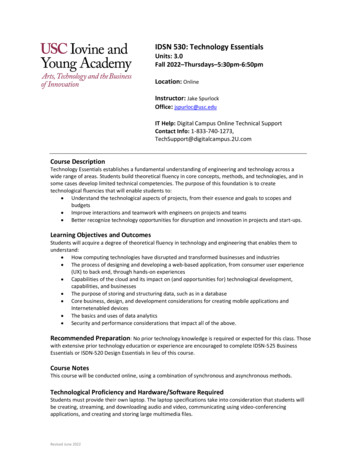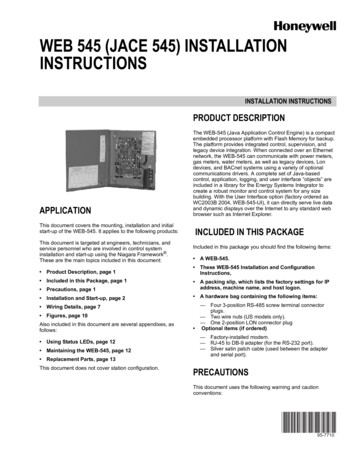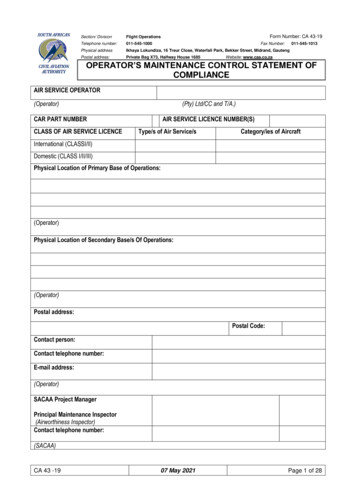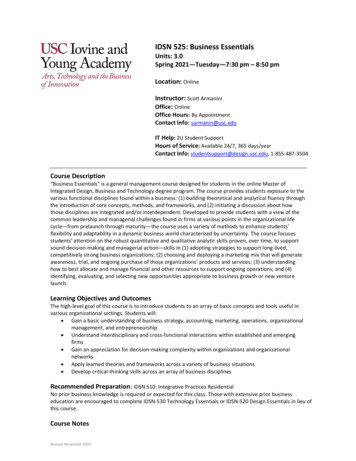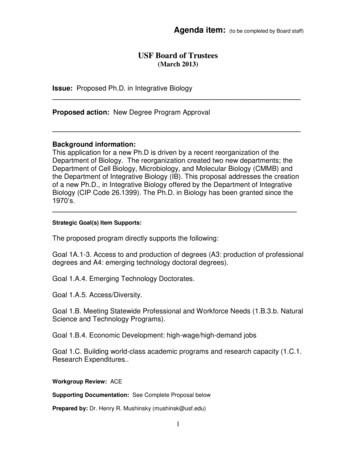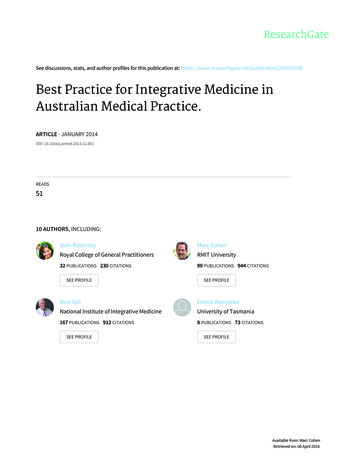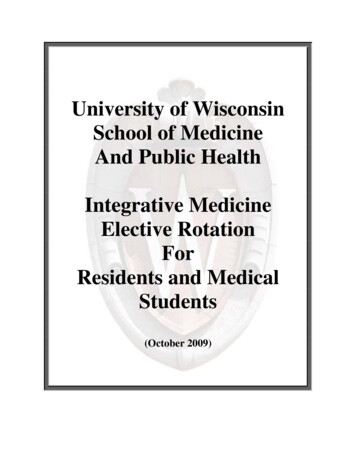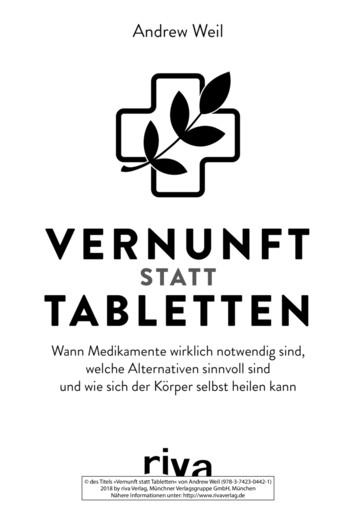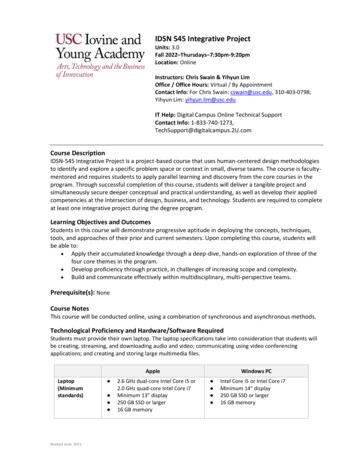
Transcription
IDSN 545 Integrative ProjectUnits: 3.0Fall 2022–Thursdays–7:30pm-9:20pmLocation: OnlineInstructors: Chris Swain & Yihyun LimOffice / Office Hours: Virtual / By AppointmentContact Info: For Chris Swain: cswain@usc.edu, 310-403-0798;Yihyun Lim: yihyun.lim@usc.eduIT Help: Digital Campus Online Technical SupportContact Info: rse DescriptionIDSN-545 Integrative Project is a project-based course that uses human-centered design methodologiesto identify and explore a specific problem space or context in small, diverse teams. The course is facultymentored and requires students to apply parallel learning and discovery from the core courses in theprogram. Through successful completion of this course, students will deliver a tangible project andsimultaneously secure deeper conceptual and practical understanding, as well as develop their appliedcompetencies at the intersection of design, business, and technology. Students are required to completeat least one integrative project during the degree program.Learning Objectives and OutcomesStudents in this course will demonstrate progressive aptitude in deploying the concepts, techniques,tools, and approaches of their prior and current semesters. Upon completing this course, students willbe able to: Apply their accumulated knowledge through a deep-dive, hands-on exploration of three of thefour core themes in the program. Develop proficiency through practice, in challenges of increasing scope and complexity. Build and communicate effectively within multidisciplinary, multi-perspective teams.Prerequisite(s): NoneCourse NotesThis course will be conducted online, using a combination of synchronous and asynchronous methods.Technological Proficiency and Hardware/Software RequiredStudents must provide their own laptop. The laptop specifications take into consideration that students willbe creating, streaming, and downloading audio and video; communicating using video conferencingapplications; and creating and storing large multimedia files.AppleLaptop(Minimumstandards)Revised June 2021 2.6 GHz dual-core Intel Core i5 or2.0 GHz quad-core Intel Core i7Minimum 13” display250 GB SSD or larger16 GB memoryWindows PC Intel Core i5 or Intel Core i7Minimum 14” display250 GB SSD or larger16 GB memory
Warranty Manufacturer warranty orextended warranty coverage(AppleCare) Manufacturer warranty orextended warranty coverageOperatingSystem Mac OS X 10.13 or higher Windows 7, 10 operating system orhigherPeripherals HD webcam, speakers and microphone (Most newer laptops have built-inwebcam, speakers and microphone)HeadsetDigital camera (Cameras on newer smartphones are acceptable)External drive for cloud account for backup and storageSoftware Adobe Creative Cloud (Photoshop, Illustrator, and InDesign)Adobe Acrobat ReaderMicrosoft Office SuiteSophos Endpoint Security (antivirus)Browser: Most recent version of Firefox, Chrome, Safari, or Internet ExplorerNetwork Cable modem, DSL, T1/T3 or higherRequired Readings and Supplementary MaterialsRequired reading will be drawn from textbooks, articles, papers, cases, and online publications (e.g.,articles, op-ed essays) available through a host of available outlets; in all instances, the material will bedelivered via computer. Students will also be required to view online videos; complete web-based,interactive exercises; and respond to peer and faculty comments (within an online discussion forum orgroup discussion). Lectures, readings, and viewings will be supplemented with current articles andaudio/video content.Description and Assessment of AssignmentsBelow are brief overviews of each assignment and deliverable. Unless specified otherwise, all assignmentswill be submitted within the 2U Learning Management System (LMS). If you experience technical difficultiessubmitting assignments, email the course instructors directly and utilize 2U student support for assistance.Additional assignment details will be provided separately.Executive Summary (individual)Each student will provide an initial project proposal in which one or more ideas for further pursuit areproposed (with accompanying rationale) to peers, faculty, and industry experts. You may format yourexecutive summary in any way you see fit to best sell your idea, but as a minimum, please address eachof the following: Goal of the project (subject area you are focusing on, symptom or pain points you areaddressing, opportunity to identify) Possible solution(s). It is not expected to show refined solutions, but it is important to showpossibilities to excite and attract teammates. Resources/knowledge do you have available (technical, conceptual, human, financial) What do you not know about the project area? Notes about important roles/duties for the project in the following four areas:o Leadership, Design, Business, TechnologyRevised Executive Summary (team)Syllabus for IDSN 545, Page 2
Team will revisit the original proposal, and as a group will draft a revised project summary.Mind Map (team)A visual representation of the project’s scope and direction. The Mind Map will include branchesrepresenting anticipated or intended audience for the project idea or product and potential mediums orformats that would be appropriate for message and audience. Mind Map will also identify at least threeresearch areas and key questions to be asked and answered in the project. It should also uncover someknown unknowns.Initial Research and Annotated Bibliography (team)Having previously identified areas to be researched, or “known unknowns”, an outline of what theresearch produced and conclusions reached including: Indicate the question researched (ideally, this will tie out to the mind map Research nodesyou brainstormed) For each section/conclusion indicate the members involved in that research (every teammember is expected to contribute to this research) Summarize the findings. We don’t need to wade through pages of detail, but they shouldclearly be reflected and in many cases, specifics should be footnoted or put into anappendix. Annotated Bibliography of sources for research Identified areas to conduct human research/interviewsUser Research (individual)The team will divide up human research/interview areas identified in the previous research. EACHmember must conduct interviews and summarize their findings from each subject. Individual membersshould share their conclusions with the group to help form an updated Problem Definition.Research Insights (team)Synthesize conclusions from all stages of research and highlight most valuable findings. This is a teamdeliverable and should be combined into a maximum 1-3 page document, so these should be findingsacross all secondary and individual primary research.Problem and Solution plus 3 Features Presentation (team)Discussion of defined problem statement, proposed solution, and three core features of your project todate. Make sure you are addressing the target audience (not instructors) and that you are engaging theneeds and interests of your potential customers. Ensure that each proposed feature addresses a need,pain point, or desire of the target audience. First slide must define the core problem for the problem/project The solution should be presented with a maximum of three slides The features should be presented at a high level and illustrate intended valueTeam-Defined Deliverable (team)Pitch a team-defined deliverable, choosing from the set of methodologies and frameworks offered byyour instructor(s), or propose another deliverable and provide reasoning to instructors for approval. Thegoal of this deliverable is to fill in a gap in your project work, and/or address an identified need notoutlined in the course and syllabus. Additional details will be provided in the live sessions prior to thisassignment.Syllabus for IDSN 545, Page 3
Deliverables, Milestones and Gantt Chart (team)Specifications for what activities and deliverables will be completed, by whom, and when. You will mapthe timelines, responsibilities, and internal team deadlines to meet the needs of this project during theproduction and testing phases.Weekly Group Check-Ins (team)Progress update. Teams must submit weekly check-ins during the production phase as outlined in theCourse Schedule. Instructors will provide a template to help in formatting the weekly team summaries.User Feedback (team)Get your product in front of real people and get their feedback. This could be potential customers,stakeholders, employees, etc. Whether your project is at the business plan mock-ups, field testing, oris a mature product in beta, it is always useful to get reactions, suggestions and insights from actualpeople who are not part of your project. For this deliverable, besides some higher-level summary of thefindings, you should have actual quotes with attributions. And yes, you can use some of your peers fromthe program as subjects but must also have non-USC people – for subjects you can draw on industry,your current companies, connections you’ve made through the project, and even (and sometimes mostimportantly) the general public.Final Presentation (team)Presentation and public launch of the project. In your final presentation, also consider the futureimplications and grand vision of your initiative, informed by material on Thinking Long Term fromNarrative and Storytelling.Handoff Document (team)Final project handoff information for future teams. This document will bring a brand-new team up tospeed on your project. The handoff should include from high-level view to granular details. There aretwo elements of the handoff document: A one- to three- page "cover sheet" pdf, and a zip archive offiles and documents from the project.Cover Sheet for Handoff Document (pdf or doc): Project title/name and date List of all team members Abstract: A one-to-four sentence description Summary of semester work: In about a half page, describe where the project started thissemester, the progress/outcome of the semester's work, and general thoughts on "next steps"beyond this semester. Reserving the project: Yes/No. If yes, and you do NOT want the project to be open to futuregroups to take over, write up the parameters your team plans. I.e. members A, B, and C plan ontaking it to another IP, to Capstone, starting up a new business venture, etc. NOTE: Only projectsoriginated/conceived by the group are eligible. Link to Project Archive: Should include all presentations, weekly updates, research materials,group ideation exercises, and anything your team made or found that applies to the project.Final Project Assessment (no deliverable)Syllabus for IDSN 545, Page 4
An evaluation of the progress and quality of your project through the semester as represented by thefinal presentation, handoff document, and your peer evaluation. No additional deliverable is requiredfor this assignment.Grading BreakdownAssignmentsExecutive Summary (Project Pitch)Revised Executive SummaryMind MapInitial Research and BibliographyUser ResearchResearch InsightsProblem and Solution plus 3 Features PresentationTeam-Defined DeliverableDeliverable, Milestones and Gantt ChartWeekly Check-InsUser FeedbackFinal PresentationHandoff DocumentFinal Project AssessmentTotalPoints25305050605075505010 x 5%25%100%Grading ScaleFinal course grades will be determined using the following scale:Letter GradeNumerical ScoreA95-100A-90-94B 87-89B83-86B-80-82C 77-79C73-76C-70-72D 67-69D63-66D-60-62Syllabus for IDSN 545, Page 5
F59 and belowAssignment RubricsDetailed assignment rubrics will be made available by the course instructors in the first week of class.Assignment Submission PolicyAll assignments must be delivered by the date and time (Pacific Time) that deliverable is listed as due perinstructor guidelines. The instructor(s) will provide due dates for all assignments and deliverables during thefirst week of the Capstone. Late assignments will be subject to the late submission policy indicated below. Allassignments must be completed in order to pass this class.Late SubmissionsAssignments will be accepted after the deadline with the following grade penalties. Do not ask forextensions; the below are the extensions.Submission in the 24 hours after the deadlineSubmission between 24 and 48 hours after the deadlineSubmission between 48 hours and 3 days after the deadlineSubmission more than 3 days after the deadline10% deduction20% deduction50% deduction100% deductionKeep copies of all your files and emails until the end of the semester.Grading TimelineInstructors will provide feedback and grading on all deliverables in a timely manner, usually within 48-72hours following an on-time submission.Correcting a Grading Error or Disputing a GradeIf you don’t inform the instructor of missing or incorrect grades within two weeks of those grades beingposted, the grades will be assumed correct. Do not wait until the semester’s end to check or appeal anygrades. If you feel a grade merits re-evaluation, you are encouraged, within one week of the instructorproviding a grade and initial feedback, to send the instructor a memo in which you request reconsideration.The memo should include a thoughtful and professional explanation of your concerns. Be aware that the reevaluation process can result in three types of grade adjustments: positive, none, or negative. (Note:Complaints on the date of a graded assignment’s return to you will not be addressed; it is essential to waitone full day prior to raising a concern.)Academy Attendance PolicyThe Academy maintains rigorous academic standards for its students and on-time attendance at all classmeetings is expected. Each student will be allowed two excused absences over the course of the semester forwhich no explanation is required. Students are admonished to not waste excused absences on non-criticalissues, and to use them carefully for illness or other issues that may arise unexpectedly. Except in the case ofprolonged illness or other serious issue (see below), no additional absences will be excused. Each unexcusedabsence will result in the lowering of the final grade by ⅓ of a grade (e.g., an A will be lowered to A-, and Awill be lowered to a B , etc.). In addition, being tardy to class will count as one-third of an absence. Threetardies will equal a full course absence.Students remain responsible for any missed work from excused or unexcused absences. Immediatelyfollowing an absence, students should contact the instructor to obtain missed assignments or lecture notesSyllabus for IDSN 545, Page 6
and to confirm new deadlines or due dates. Extensions or other accommodations are at the discretion of theinstructor.Automatically excused absences normally may not be used for quiz, exam or presentation days. Using anexcused absence for a quiz, exam or presentation, such as in the case of sudden illness or other emergency, isat the discretion of the instructor.In the case of prolonged illness, family emergencies, or other unforeseen serious issues, the student shouldcontact the instructor to arrange for accommodation. Accommodation may also be made for essentialprofessional or career-related events or opportunities. All accommodations remain at the discretion of theinstructor, and appropriate documentation may be required.Additional PoliciesClass notes policy: Notes or recordings made by students based on a university class or lecture may only bemade for purposes of individual or group study, or for other non-commercial purposes that reasonably arisefrom the student’s membership in the class or attendance at the university. This restriction also applies toany information distributed, disseminated, or in any way displayed for use in relation to the class, whetherobtained in class, via e-mail or otherwise on the Internet, or via any other medium. Actions in violation of thispolicy constitute a violation of the Student Conduct Code, and may subject an individual or entity touniversity discipline and/or legal proceedings. Again, it is a violation of USC’s Academic Integrity Policies toshare course materials with others without permission from the instructor.No recording and copyright notice: No student may record any lecture, class discussion or meeting with theinstructor without his/her prior express written permission. The word “record” or the act of recordingincludes, but is not limited to, any and all means by which sound or visual images can be stored, duplicated,or retransmitted whether by an electro-mechanical, analog, digital, wire, electronic or other device or anyother means of signal encoding. The instructor reserves all rights, including copyright, to his/her lectures,course syllabi and related materials, including summaries, slides (e.g., Keynote, PowerPoint), prior exams,answer keys, and all supplementary course materials available to the students enrolled in the class whetherposted to the LMS or otherwise. They may not be reproduced, distributed, copied, or disseminated in anymedia or in any form, including but not limited to all course note-sharing websites. Exceptions are made forstudents who have made prior arrangements with The USC Office of Disability Services and Programs and theinstructor.Participation: Students are expected to actively participate in this course. In an online forum, participationincludes: Careful reading and viewing of assigned materials by the date due Regular, substantive contributions to discussions Active engagement with online content On-time attendance and full attention (with camera on) in synchronous sessions Significant collaboration with classmates and teammatesCourse grades may be affected for students who do not contribute to the course through active participation.Students should notify the instructor in advance if they are unable to attend class. Those unable to attendwill be required to review the online recording for the session missed, and submit thoughtful feedback to theInstructor.Contact HoursSyllabus for IDSN 545, Page 7
This 2-unit course requires 750 minutes of instructional time per semester, which equals 50 minutes ofinstructional time each week. Instructional time may be further broken down into 25 minutes ofasynchronous time and 25 minutes of synchronous time. In addition, it is expected that students willwork, on average, an additional 200 minutes per week outside of class — on readings/viewings,homework assignments, field experiences, and individual or team projects. Synchronous class sessionswill be offered as regularly scheduled evening or weekend classes, once each week.Syllabus for IDSN 545, Page 8
Course Schedule: A Weekly BreakdownUnitTitle and TopicsReadingsDeliverables1Ideas and TeamsProject OverviewExecutive Summary (individual)1Ideas and TeamsProject PitchesProject Pitches (live)Project Pitch Survey1Ideas and TeamsTeamsRevised Executive Summary2Research andDefinitionBrainstorming and MindMappingMind Map2Research andDefinitionResearchInitial Research, Bibliography2Research andDefinitionProblem DefinitionUser Research (individual)Research Insights2Research andDefinition3Production3ProductionWeekly Check-In 13ProductionWeekly Check-In 2Peer Assessment Survey3ProductionWeekly Check-In 33ProductionWeekly Check-In 43ProductionWeekly Check-In 5User Feedback3ProductionWeekly Check-In 64PresentationProblem and Solution plus 3 FeaturesPresentation (live)Gantt ChartsDeliverables andMilestonesFinal PresentationsTeam-Defined DeliverableDeliverables, Milestones and Gantt ChartFinal Presentation (live)Handoff DocumentPeer Assessment SurveySyllabus for IDSN 545, Page 9
Statement on Academic Conduct and Support SystemsAcademic Conduct:Plagiarism – presenting someone else’s ideas as your own, either verbatim or recast in your own words – is aserious academic offense with serious consequences. Please familiarize yourself with the discussion ofplagiarism in SCampus in Part B, Section 11, “Behavior Violating University Standards”policy.usc.edu/scampus-part-b. Other forms of academic dishonesty are equally unacceptable. See additionalinformation in SCampus and university policies on scientific misconduct, policy.usc.edu/scientific-misconduct.Support Systems:Student Health Counseling Services - (213) 740-7711 – 24/7 on callengemannshc.usc.edu/counselingFree and confidential mental health treatment for students, including short-term psychotherapy, groupcounseling, stress fitness workshops, and crisis intervention.National Suicide Prevention Lifeline - 1 (800) 273-8255 – 24/7 on callsuicidepreventionlifeline.orgFree and confidential emotional support to people in suicidal crisis or emotional distress 24 hours a day, 7days a week.Relationship and Sexual Violence Prevention Services (RSVP)213-740-9355 Free and confidential therapy services, workshops, and training for situations related to gender-based harm.Relationship and Sexual Violence Prevention and Services provides immediate therapy services for situationsrelated to gender- and power-based harm (e.g., sexual assault, domestic violence, stalking).Office of Equity and Diversity (OED) Title IX - (213) 740-5086equity.usc.edu, titleix.usc.eduInformation about how to get help or help a survivor of harassment or discrimination, rights of protectedclasses, reporting options, and additional resources for students, faculty, staff, visitors, and applicants. Theuniversity prohibits discrimination or harassment based on the following protected characteristics: race,color, national origin, ancestry, religion, sex, gender, gender identity, gender expression, sexual orientation,age, physical disability, medical condition, mental disability, marital status, pregnancy, veteran status, geneticinformation, and any other characteristic which may be specified in applicable laws and governmentalregulations.USC Policy Reporting to Title IX (213) ix-student-misconduct/The university encourages individuals to report prohibited conduct to the Title IX Office. Individuals canreport to the university's Title IX Coordinator in the Office of Equity and Diversity.Bias Assessment Response and Support - (213) ponse-supportAvenue to report incidents of bias, hate crimes, and microaggressions for appropriate investigation andresponse.Syllabus for IDSN 545, Page 10
The Office of Disability Services and Programs - (213) 740-0776dsp.usc.eduSupport and accommodations for students with disabilities. Services include assistance in providingreaders/notetakers/interpreters, special accommodations for test taking needs, assistance with architecturalbarriers, assistive technology, and support for individual needs.USC Support and Advocacy - (213) 821-4710studentaffairs.usc.edu/ssaAssists students and families in resolving complex personal, financial, and academic issues adversely affectingtheir success as a student.Diversity at USC - (213) 740-2101diversity.usc.eduInformation on events, programs and training, the Provost’s Diversity and Inclusion Council, Diversity Liaisonsfor each academic school, chronology, participation, and various resources for students.USC Emergency - UPC: (213) 740-4321, HSC: (323) 442-1000 – 24/7 on calldps.usc.edu, emergency.usc.eduEmergency assistance and avenue to report a crime. Latest updates regarding safety, including ways in whichinstruction will be continued if an officially declared emergency makes travel to campus infeasible.USC Department of Public Safety - UPC: (213) 740-6000, HSC: (323) 442-120 – 24/7 on calldps.usc.eduNon-emergency assistance or information.Syllabus for IDSN 545, Page 11
production and testing phases. Weekly Group Check-Ins (team) Progress update. Teams must submit weekly check-ins during the production phase as outlined in the Course Schedule. Instructors will provide a template to help in formatting the weekly team summaries. User Feedback (team) Get your product in front of real people and get their feedback.
